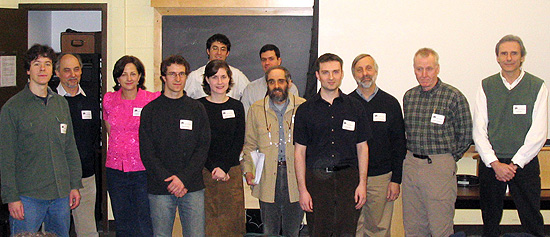Neuroscience and Behavior Alumni Present Research, Offer Advice
 |
|
Pictured left to right, front row: Gloster Aaron, assistant professor of biology; John Seamon, professor of psychology; Janice Naegele, associate professor of biology; John Dekker, candidate, department of neurobiology, Harvard Medical School; Megan Carey, postdoctoral fellow, neurobiology department, Harvard Medical School; Allan Berlind, professor of biology, emeritus; Joshua Gooley, postdoctoral fellow, Division of Sleep Medicine, Brigham and Women’s Hospital; David Bodznick, professor of biology; Harry Sinnamon, professor of psychology; John Kirn, chair, neuroscience and behavior program and associate professor, biology; Back row: Sam Sober, postdoctoral fellow, Keck Center for Integrative Neuroscience, UCSF and Mauricio Delgado, assistant professor, department of psychology, Rutgers University. |
| Posted 02/16/06 |
| The Neuroscience and Behavior Symposium was held at Wesleyan University on Feb. 11.
Organized by John Kirn, associate professor of biology, neuroscience and behavior (NS&B) and Chair of Wesleyans Neuroscience & Behavior Program, the symposium was designed to allow current Wesleyan undergraduates to discuss the major and research with established alumni of the Neuroscience & Behavior Department. Nearly 60 people attended the symposium, which was followed by lunch and an informal panel discussion. I think that current students like to hear first hand about the experiences of others who are a few steps further along in their career paths, says Kirn, who hoped to also attract to the symposium Wesleyan students who dont conduct research, and who have limited interactions with graduate students. All of our current majors doing research interact with our own graduate students and I think this is a very important mentoring process – yet another reason why we are lucky to have a Ph.D. program, he says. Kirn also says the conference was a great opportunity for current students to learn how the speakers structured their own educations at Wesleyan and to find out what their lives are like now. Current Wesleyan students, like Emily Gallivan and Jessica Ghofrani, both Sophomore NS&B majors, were happy with the small, intimate symposium setting and found the presentations interesting. Junior NS&B major Tarek Sami agrees. I liked hearing about the history of the department and this was a great opportunity to meet alumni and current faculty in the department, he says. One of the symposiums featured speakers was alumna Megan Carey 96, now a postdoctoral fellow at Harvard Medical School. Carey also received a masters from Wesleyan Universitys NS&B department in 1997. She presented a talk on her Ph.D, thesis which she earned from the University of California at San Francisco (UCSF), titled Visual instructive signals for motor learning. Careys work suggests a mechanism for how sensory signals represented in specific brain areas can lead to changes in neuronal activities that trigger learned behaviors, such as riding a bike or playing tennis. Carey studied the repeated eye movements of monkeys in order to gather her information. Another alumni, Sam Sober 98, discussed his Ph.D. dissertation research, titled Sensory Integration During Motor Planning. Sober, who also received his Ph.D. from UCSF, is now a postdoctoral fellow at UCSFs Keck Center for Integrative Neuroscience. He spoke about his Ph.D., which involved analyzing the movements that human subjects made when reaching towards targets in a virtual reality environment. Sober used virtual reality to alter visual imagery, by shifting an image of the subjects arm away from its true location. This led to people making reaching errors, explains Sober. We analyzed these errors and found that the brain is very adaptable in how it combines visual information with proprioceptive (the felt sense of posture) information. Sober says that although his studies focused on healthy individuals, a basic understanding of how the brain integrates different sources of information could help us understand disorders resulting from strokes and traumatic brain injuries. Sober, who earned a Luce Fellowship, took a year off after graduating from Wesleyan to study acupuncture in Korea. He told the audience that taking a year off between finishing undergraduate studies and beginning graduatestudies or medical school was a good way to stem potential burn out. Other presentations included Entrainment of the Circadian Timing System, by Joshua Gooley 00; Reward-related processing in the human striatum, by Mauricio Delgado 97 and Single Channel Analysis of Mammalian HCN Gating, by John Dekker 98, 99. These speakers, who once did research in our labs, are now doing excellent work and we wanted to recognize them for their achievements, says Kirn. Based on suggestions of some students, wed like to host something like this again with alumni who arent in academic positions with a theme like Just what can I do with this NS&B degree anyway? |
| By Laura Perillo, associate director of Media Relations |

